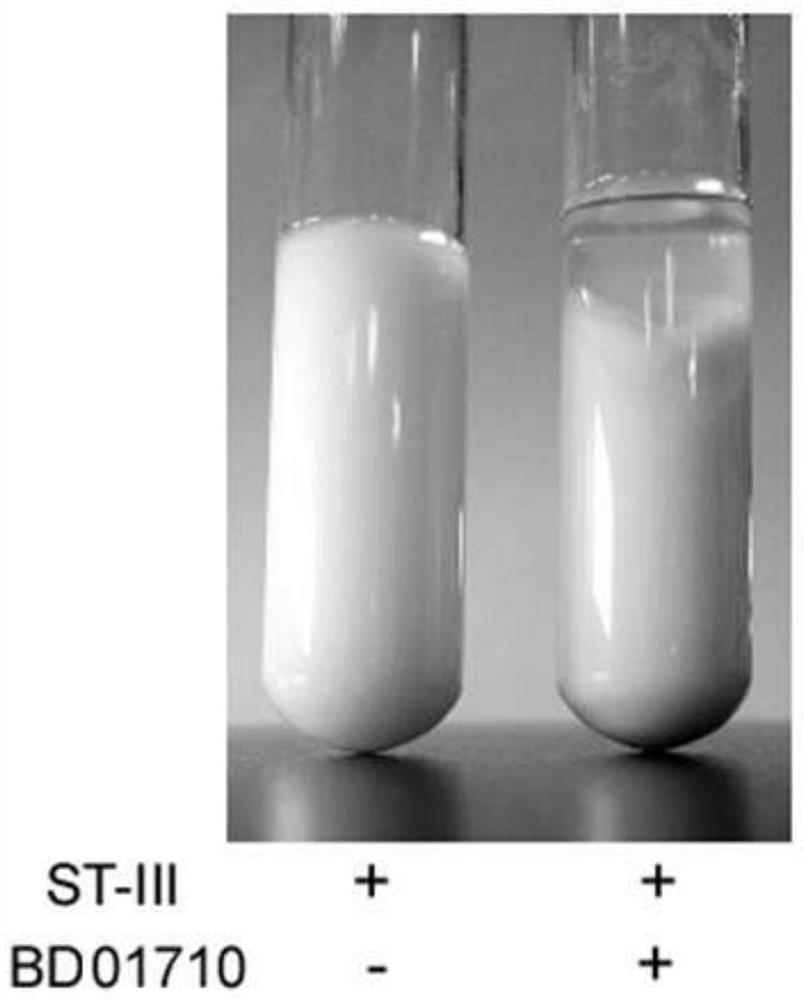A method for promoting the growth of plant lactobacillus st-iii
A technology of ST-III, Lactobacillus plantarum, applied in the field of microbial fermentation, to achieve obvious growth promotion effect
- Summary
- Abstract
- Description
- Claims
- Application Information
AI Technical Summary
Problems solved by technology
Method used
Image
Examples
Embodiment 1
[0034] Raw material preparation: raw milk, made up of 10% whole milk powder or skimmed milk powder, 5% sucrose and 100% water, after fully dissolving, mixing uniformly, homogeneous (70℃, 22MPa), 95℃ sterilization 10min, cool to 45℃ for later use.
[0035] Inoculate the raw milk separately with Lactobacillus plantarum ST-III (10 7 CFU / mL) and Leuconostoc mesenteroides BD01710 (3×10 6 CFU / mL), stir and mix evenly and then culture, the culture temperature is 37°C, the culture time is 24h, and the fermented milk sample is obtained.
[0036] The above fermented milk samples were sampled and counted by the plate counting method after gradient dilution. Compared with only inoculating Lactobacillus plantarum ST-III under the same conditions, the results are shown in Table 1. It can be seen that the content of active Lactobacillus plantarum ST-III in the fermented milk is higher than 5×10 8 CFU / mL.
[0037] Table 1: The pH value and the number of viable bacteria of the fermented milk sample ...
Embodiment 2
[0040] Raw material preparation: raw milk, made up of 10% whole milk powder or skimmed milk powder, 5% sucrose and 100% water, after fully dissolving, mixing uniformly, homogeneous (70℃, 22MPa), 95℃ sterilization 10min, cool to 45℃ for later use.
[0041] Inoculate the raw milk with Lactobacillus plantarum ST-III (10 7 CFU / mL) and Leuconostoc mesenteroides BD01710 (10 6 CFU / mL), stir and mix evenly and then culture, the culture temperature is 40°C, the culture time is 26h, and the fermented milk sample is obtained.
[0042] The above fermented milk samples were sampled and counted by the plate counting method after gradient dilution. Compared with only inoculating Lactobacillus plantarum ST-III under the same conditions, the results obtained are shown in Table 2. It can be seen that the content of active Lactobacillus plantarum ST-III in the fermented milk is higher than 5×10 8 CFU / mL.
[0043] Table 2: The pH value and the number of viable bacteria of the fermented milk sample of E...
Embodiment 3
[0046] Raw material preparation: The culture medium is raw milk, which is made up of 10% whole milk powder or skim milk powder, 5% sucrose and 100% water, after being fully dissolved, mixed evenly, and homogeneous (60°C, 22MPa), Sterilize at 95°C for 5min, then cool to 40°C for later use.
[0047] Inoculate the raw milk with Lactobacillus plantarum ST-III (10 6 CFU / mL) and Leuconostoc mesenteroides BD01710 (10 7 CFU / mL), stir and mix evenly and then culture, the culture temperature is 35°C, the culture time is 18h, and the fermented milk sample is obtained.
[0048] The above fermented milk samples were sampled and counted by the plate counting method after gradient dilution. Compared with only inoculating Lactobacillus plantarum ST-III under the same conditions, the results are shown in Table 3. The content of active Lactobacillus plantarum in the fermented milk is higher than 5×10 8 CFU / mL.
[0049] Table 3: The pH value and the number of viable bacteria of the fermented milk samp...
PUM
 Login to View More
Login to View More Abstract
Description
Claims
Application Information
 Login to View More
Login to View More - R&D
- Intellectual Property
- Life Sciences
- Materials
- Tech Scout
- Unparalleled Data Quality
- Higher Quality Content
- 60% Fewer Hallucinations
Browse by: Latest US Patents, China's latest patents, Technical Efficacy Thesaurus, Application Domain, Technology Topic, Popular Technical Reports.
© 2025 PatSnap. All rights reserved.Legal|Privacy policy|Modern Slavery Act Transparency Statement|Sitemap|About US| Contact US: help@patsnap.com



